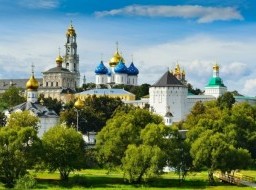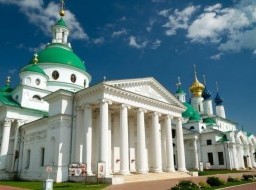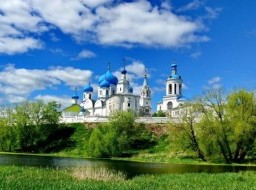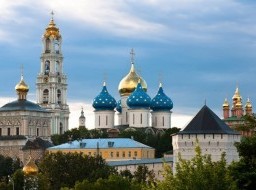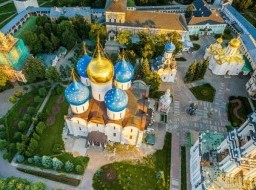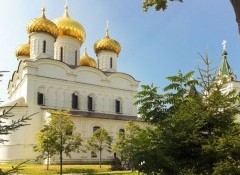Kremlin
The Kremlin is the main attraction of Pskov, its architectural and historical center. This old building, majestically rising on a rocky promontory, is considered one of the best examples of ancient Russia defensive architecture. The height of the strong walls of Krom, occupying an area of 3 ha, comes to 8 meters, while their thickness is 6 meters. Nobody knows, when the Kremlin walls were established, or when its first tower out of its numerous ones (there are seven of them with a sightseeing platform, built on the Vlasiev Tower) was erected, while the Kremlin fortress as already existing one was first mentioned in written records of 1605. The Pskov Kremlin, together with the other city’s fortifications, experienced more than a hundred wars and dozens of sieges, but actually, was destroyed only once - as a result of betrayal, rather than the fall of the walls. This long-suffering fortification surrendered only to the fascist invasion: after occupation by the Nazi, the Krom, which was in active military use nearly 1,000 years, turned into ruins. To visit the Pskov Kremlin, which is now restored, is better in the evening in order to enjoy the sound of bells, cast in XVI - XVII centuries, and to listen to the Cathedral Choir singing during a divine service at the Trinity Cathedral. Pskov's Kremlin (Krom) The best way to get to know the ancient city is to begin at the very spot where the city itself began - at its original for-tress, the Krom. This fortress stands on a long, rocky promontory between the Pskova and Velikaya rivers. The height of this decayed сrumbling cliff, over-grown with grass and bushes, can be easily seen from the rivers, and the Krom's mighty walls can be viewed from the Velikaya bank. The road to the Krom leads through Dovmont's Town, or "the Pskov Pompeii", as it is sometimes called, an open air archaeological preserve. The Krom wall facing this way was exposed to assault. It was called Pershi or Persi, from the old Russian word "persi", meaning "chest". Enemy forces stormed the Krom from this side, where there were no rivers to protect it. To defend the wall, the men of Pskov carved a moat in the cliff on which the Krom stands. This moat, called the "Greblya", joined the Pskova and Veli- kaya rivers and was filled with water. It was very deep and the Pershi wall rose more than twenty metres above it. This wall is now more than half sunk into the ground, and the entrance to the Krom does not, in fact, lie through the gate, but through a "window" cut above the ancient gate. There were two gates, one at either end of the Pershi wall: to the right were the main gates - the Holy Gates, or Tyomnye (Dark) Gates, the main en-trance to the Krom, and to the left were the "Smerdy" Gates for the common people (peasants were called "smerdi"). There were two bridges across the moat: the Great Bridge, leading to the main gates (on the site of today's en-trance to the Krom), and the Smerdi Bridge, leading to the gates of the same name.In the middle of the Pershi wall there was a belfry in the shape of a small, tent-roofed tower where the bells of Trinity Cathedral hung. Two of these bells were especially important: one summoned the people to the veche, attended by all the people, and the other, to the state council. (The belfry was built together with the Pershi wall in 1393, and afterwards rebuilt several times.) A second fortified wall guarding the main gates from the inside and called the zakhab was built near the Pershi wall. Perhaps due to its position inside the gates were called "Dark". State prisoners were held in cellars beneath this second wall. The road turned slightly uphill from the gates leading into the Krom and the interior of the Krom gradually came into view. By contrast with the narrow passageway of the "zakhab" the impression inside was magnificent - and this is the effect the architects aimed to create. Today this is one of the best spots to view the cathe-dral and belfry. Trinity Cathedral Trinity Cathedral divides the Krom's territory into two unequal parts. The smaller part lies in front of the cathedral and the larger part behind it. The cathe-dral stands close to the Pershi wall, the city, and the gates. The steps leading up to the cathedral almost touch one of the Krom's walls and the sanctuary apses lead up to the other wall. The wall on the south side of the cathedral is the most important one, for it was here that the Pskov veche, which had legislative au-thority, met. It could make changes in the "Pskov Legal Code", made decisions on questions of war and peace, invited princes to rule over the city, and decided on construction, taxes, and capital pun-ishment. Resolutions were drawn up by the city council and presented to the veche for a vote. The entire free male population of the city took part in the veche. Representatives of Pskov's "sub-urbs" (the smaller fortified cities in the principality of Pskov) who were present in Pskov at the time could a also attend the veche. Inhabitants of each district of the city stood together at the veche and discussed questions among themselves, shouting out their approval or dis-approval. Sometimes disagreements led to enormous brawls. A podium stood above the veche square where the "current" and "elder" mayors, commander, and the prince sat, forming a presiding committee over the veche. (There were either one or two current mayors in Pskov at any given time. "Elder" mayors were ex-mayors who then went on to serve on the state council. The commanders headed the Pskov home guard.) The prince did not have much authority in Pskov: he was simply the commander-in-chief of the troops. The prince's troops consolidated Pskov's military might. In peacetime, the prince - with representatives of the city - conducted court trials, for which he was "fed" (i.e. maintained). An in-competent prince could even be physi-cally kicked off the veche podium (the Pskov chronicle records one such in-cident). In 1978-79, an archaeological ex-pedition from the Hermitage Museum headed by Vasily Beletsky unearthed the foundation of Pskov's veche podium. It was located near Trinity Cathedral. In the 14th-century layer archaeologists found a stone semi-circle six metres in diameter. Remnants of a wooden floor were found inside it. Another such floor was found outside it half a metre lower down. The podium was located in the eastern part of the veche square; tradi-tion had it that those present should face east. Beneath this foundation archaeolo-gists found a stone foundation of the same shape - part of an earlier podium. If you walk to the southwest cor-ner of the Krom's inner grounds where Smerdya Tower stands (Smerdy Gates used to be beside this tower), you will see something unusual: you are walking on top of some buildings. Excavations have been carried out on this spot, and the arches of ancient buildings and walls going very deep into the ground have been unearthed; you can see the founda-tion of Smerdya Tower, which was large and round, and turned into a small, faceted tower above ground only during restoration work in the second quarter of the 19th century. You can see clearly that Trinity Cathedral stands on a cliff top, some idea of which you can get by comparing the level of the ground today by the wall and its previous level, as seen at the excavation site. (Earth was piled up by the fortress walls inside Pskov's Krom in the early 18th century, during the Northern War, when Peter the Great fortified Pskov; the "cultural layer", as archaeologists call it, meaning what is deposited over the centuries, also grew. No one lived in the Krom. There were storerooms built close together behind the cathedral, where a large green meadow lies today. . State and private property, and grain stores were kept here, as well as a powder store. The Pskov chronicle relates that there was a huge explosion of the powder stores during a fire in May 1608, when both of the Krom's walls - facing the Pskova and the Velikaya rivers - were destroyed. The Krom was guarded by dogs, and their food was kept in the Snetnaya Tower (from the word "sned", meaning "food" in Old Russianl When the bell-tower on the Pershi wall was destroyed, the Snetnaya Tower became the Trinity Cathedral bell-tower. The tower is older than the cathedral, as shown by its archaic masonry. An act of robbery inside the Krom was regarded as a serious crime punishable by death, along with treason, sacrilege, and horse-stealing. If you walk over to the Krom's north-west corner where Kutekrom Tower stands ("kuta" being the word for "cor-ner"), you will find yourself standing at the very spot where Pushkin liked to look at the Velikaya River. The 19th-century building behind Trinity Cathe-dral is now used as an exhibition hall. |

